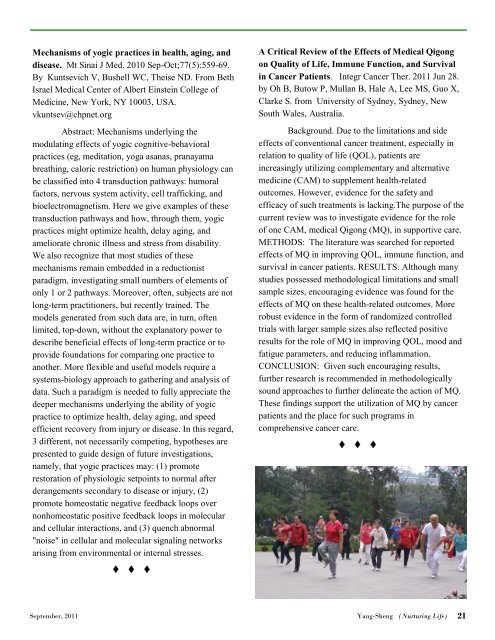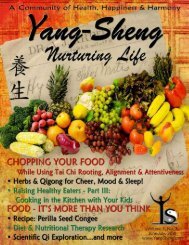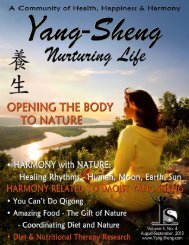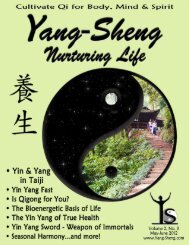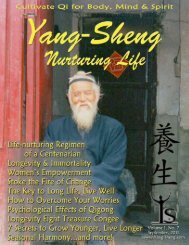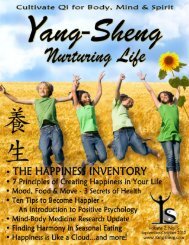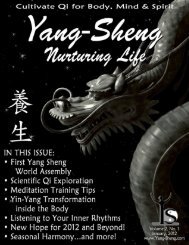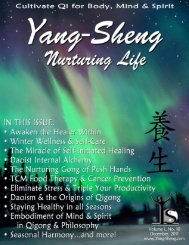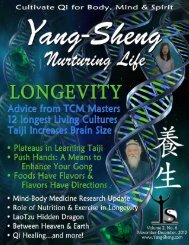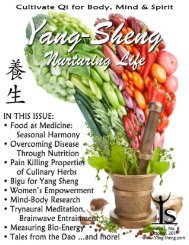Click to download the entire September issue as a PDF - Yang-Sheng
Click to download the entire September issue as a PDF - Yang-Sheng
Click to download the entire September issue as a PDF - Yang-Sheng
Create successful ePaper yourself
Turn your PDF publications into a flip-book with our unique Google optimized e-Paper software.
Mechanisms of yogic practices in health, aging, and<br />
dise<strong>as</strong>e. Mt Sinai J Med. 2010 Sep-Oct;77(5):559-69.<br />
By Kuntsevich V, Bushell WC, Theise ND. From Beth<br />
Israel Medical Center of Albert Einstein College of<br />
Medicine, New York, NY 10003, USA.<br />
vkuntsev@chpnet.org<br />
Abstract: Mechanisms underlying <strong>the</strong><br />
modulating effects of yogic cognitive-behavioral<br />
practices (eg, meditation, yoga <strong>as</strong>an<strong>as</strong>, pranayama<br />
breathing, caloric restriction) on human physiology can<br />
be cl<strong>as</strong>sified in<strong>to</strong> 4 transduction pathways: humoral<br />
fac<strong>to</strong>rs, nervous system activity, cell trafficking, and<br />
bioelectromagnetism. Here we give examples of <strong>the</strong>se<br />
transduction pathways and how, through <strong>the</strong>m, yogic<br />
practices might optimize health, delay aging, and<br />
ameliorate chronic illness and stress from disability.<br />
We also recognize that most studies of <strong>the</strong>se<br />
mechanisms remain embedded in a reductionist<br />
paradigm, investigating small numbers of elements of<br />
only 1 or 2 pathways. Moreover, often, subjects are not<br />
long-term practitioners, but recently trained. The<br />
models generated from such data are, in turn, often<br />
limited, <strong>to</strong>p-down, without <strong>the</strong> explana<strong>to</strong>ry power <strong>to</strong><br />
describe beneficial effects of long-term practice or <strong>to</strong><br />
provide foundations for comparing one practice <strong>to</strong><br />
ano<strong>the</strong>r. More flexible and useful models require a<br />
systems-biology approach <strong>to</strong> ga<strong>the</strong>ring and analysis of<br />
data. Such a paradigm is needed <strong>to</strong> fully appreciate <strong>the</strong><br />
deeper mechanisms underlying <strong>the</strong> ability of yogic<br />
practice <strong>to</strong> optimize health, delay aging, and speed<br />
efficient recovery from injury or dise<strong>as</strong>e. In this regard,<br />
3 different, not necessarily competing, hypo<strong>the</strong>ses are<br />
presented <strong>to</strong> guide design of future investigations,<br />
namely, that yogic practices may: (1) promote<br />
res<strong>to</strong>ration of physiologic setpoints <strong>to</strong> normal after<br />
derangements secondary <strong>to</strong> dise<strong>as</strong>e or injury, (2)<br />
promote homeostatic negative feedback loops over<br />
nonhomeostatic positive feedback loops in molecular<br />
and cellular interactions, and (3) quench abnormal<br />
"noise" in cellular and molecular signaling networks<br />
arising from environmental or internal stresses.<br />
<br />
<br />
A Critical Review of <strong>the</strong> Effects of Medical Qigong<br />
on Quality of Life, Immune Function, and Survival<br />
in Cancer Patients. Integr Cancer Ther. 2011 Jun 28.<br />
by Oh B, Bu<strong>to</strong>w P, Mullan B, Hale A, Lee MS, Guo X,<br />
Clarke S. from University of Sydney, Sydney, New<br />
South Wales, Australia.<br />
Background. Due <strong>to</strong> <strong>the</strong> limitations and side<br />
effects of conventional cancer treatment, especially in<br />
relation <strong>to</strong> quality of life (QOL), patients are<br />
incre<strong>as</strong>ingly utilizing complementary and alternative<br />
medicine (CAM) <strong>to</strong> supplement health-related<br />
outcomes. However, evidence for <strong>the</strong> safety and<br />
efficacy of such treatments is lacking.The purpose of <strong>the</strong><br />
current review w<strong>as</strong> <strong>to</strong> investigate evidence for <strong>the</strong> role<br />
of one CAM, medical Qigong (MQ), in supportive care.<br />
METHODS: The literature w<strong>as</strong> searched for reported<br />
effects of MQ in improving QOL, immune function, and<br />
survival in cancer patients. RESULTS: Although many<br />
studies possessed methodological limitations and small<br />
sample sizes, encouraging evidence w<strong>as</strong> found for <strong>the</strong><br />
effects of MQ on <strong>the</strong>se health-related outcomes. More<br />
robust evidence in <strong>the</strong> form of randomized controlled<br />
trials with larger sample sizes also reflected positive<br />
results for <strong>the</strong> role of MQ in improving QOL, mood and<br />
fatigue parameters, and reducing inflammation.<br />
CONCLUSION: Given such encouraging results,<br />
fur<strong>the</strong>r research is recommended in methodologically<br />
sound approaches <strong>to</strong> fur<strong>the</strong>r delineate <strong>the</strong> action of MQ.<br />
These findings support <strong>the</strong> utilization of MQ by cancer<br />
patients and <strong>the</strong> place for such programs in<br />
comprehensive cancer care.<br />
<br />
<br />
<strong>September</strong>, 2011 <strong>Yang</strong>-<strong>Sheng</strong> (Nurturing Life) 21


